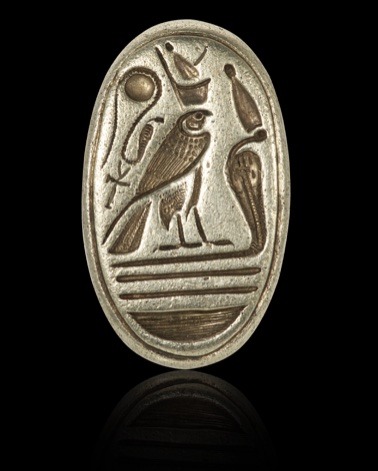#NEW KINGDOM 18TH-20TH DYNASTY CIRCA 1390-1069 B.C.
Photo



AN EGYPTIAN ELECTRUM STIRRUP RING
NEW KINGDOM, 18TH-20TH DYNASTY, CIRCA 1390-1069 B.C.
1 in. (2.5 cm.) long.
This fine stirrup-shaped signet ring would have been used either by the king himself or given by him to a high official with the authority to act on his behalf. As visible by the wear on the oval bezel, it is clear that this ring was used as a seal, probably for royal administrative documents. Solid cast stirrup rings replaced earlier seal types with swivel bezels, as the sturdy form better suited the function for which it was intended. This tradition began at the end of the 18th Dynasty and continued into the 19th.
Electrum is an alloy of gold and silver whose colors vary from greenish-yellow to silvery-grey. Gold of high purity was not easy to cast, so adding silver or copper helped avoid defects due to excessive porosity. Electrum and silver were considered more desirable than gold before the New Kingdom, whereas the much redder color of copper-gold alloys was preferred for stirrup rings during the Amarna and immediate post-Amarna period. This ring was cast through the lost wax method, while the bezel was engraved using iron or copper tools.
At the center of the oval bezel is the Horus falcon wearing the Double Crown, the symbol of the monarchy’s task to unite Upper and Lower Egypt. The feathers and facial markings are finely detailed. In front of the falcon, a rearing cobra wearing the white crown of Upper Egypt is the uraeus protector of the Crown. Behind the falcon is a cobra looped over the sun disc with an ankh around its neck, invoking the sun god Ra. Below are the two horizontal lines and the basket hieroglyph, which together can be read as ‘neb tawy’, meaning Lord of the Two Lands, an epithet of the pharaoh. The composition is exquisitely executed and balanced and is reminiscent of other masterpieces from the end of the 18th Dynasty.
#AN EGYPTIAN ELECTRUM STIRRUP RING#NEW KINGDOM 18TH-20TH DYNASTY CIRCA 1390-1069 B.C.#jewelry#ancient jewelry#ancient artifacts#archeology#archeolgst#history#history news#ancient history#ancient culture#ancient civilizations#ancient egypt#egyptian history#egyptian jewelry#egyptian art
100 notes
·
View notes